 |
|
Great Warbirds Air Displays |
|
By Robin J Brooks In 1982, a unique event took place at the former RAF airfield of West Malling in Kent - The Great Warbirds Air Display. Born from an idea formulated by Ted White, the driving force behind the acquisition of a Boeing B-17 Flying Fortress in 1975, and his close friend Elly Sallingboe. The intention was to bring together as many warbirds as possible and build an airshow around the theme of the American Confederate Air Force airshows. West Malling was chosen because it had the right atmospheric composition. A former nightfighter base during WW2 and post-war, it remained open until 1961 when the ever-encroaching air corridors for Heathrow and Gatwick in the airspace overhead forced its demise. It was used as an American Naval Facility for the two years following its closure, after which it fell into dis-use until it was purchased from the MOD by Kent County Council to, as they said at the time, “prevent it from undesirable development!” A number of aviation related companies then used the airfield including Short Brothers and Metair Aircraft Ltd together with No. 618 Volunteer Gliding School of the Air Training Corps. It was however Ted’s and Ellys plan to establish an airshow, the like of which had never been seen before. Many months of hard work and planning lay ahead before this could become a reality and the first step in achieving this was to establish a professional organising team to bring the plans together. After some extensive searching, Elly as display director, got onboard John Cuthbertson as flying director, Paddy Casey as ground organiser and Richard Lucraft as press and publicity. With the display team firmly in place, Kent County Council were approached, and later Rouse Kent Ltd, (the prospective developers of the airfield), police, fire and ambulance services. The plans were presented and approved. The show was now set for take off, and to become the foremost and the best warbirds show in the country. In due course it was also to become known for it excellence and its quality as well as for its safety We’ll Meet Again
Throughout the flying, Ted was on hand to see that no harm came to Sally B. After filming he could often be seen in the nose of the aircraft checking that no damage had been done. One scene in particular was to cause him some concern when, returning from a mission, Sally B was to be seen to belly land. However, the camera can lie and the incident was achieved by building a staging of turf and churned up grass around the aircraft until it reached the cockpit windows. Add a bogus bent propeller and it looked for the entire world as though she had come to grief. The final touch to this dramatic scene was to place a downhearted Gavin O’Herlihy next to the cockpit talking to his crashed B-17! Other scenes inside the aircraft were shot in the main hanger at West Malling where, amid a collection of cables and arc lamps, Sally B was cloaked in a sheeting fabric to give the impression of clouds and sky. The technical adviser, 57 year old Colonel Don Brewer, was himself a former bombardier and navigator based in Britain during 1944 and it was is job to ensure that the scenes were as authentic as possible. In his own words: - “everything was spot on. It makes me feel like it was just yesterday”. There is no doubt that the series was a great success, even stretching to a second showing two years later. Sadly, after filming had been completed, the tragic death of Ted whilst flying his AT-6D-NT Harvard 111 in the Malta Air Rally, shocked the aviation world. Although in deep grief, Elly took hold of the reins to ensure that B-17 and Sally B survived. She knew that for Ted’s sake, the all vintage air display that had been uppermost in their minds for some time, had to go ahead as a tribute to him. She became the leading force and main organiser of the Great Warbirds Air Display. In addition, the starboard inner engine cowling of Sally B was painted in Ted’s distinctive black and yellow chequered markings. Thus wherever the aircraft was flying, Ted was right there with her. Nostaliga was about to start in a big way
The day was dedicated to the memory of Ted with the proceeds of the day going towards the upkeep and preservation of Sally B, the IWM hangar appeal and selected charities nominated by the Kent County Council, the current owners of the airfield. Despite the very disappointing weather, a good line-up of warbirds were present although some of the aircraft due to fly in on the day of the show had to turn back and return home due to low cloud and bad visibility. With 30,000 people in attendance, the flying was superb. Sally B was supported centre stage by Ray Hanna in Spitfire Mk.IX MH434, Stephen Grey with his Mustang N6304T, the F8F Grumman Bearcat from the same stable and Lindsey Walton’s newly arrived F4U-7 Corsair, complete with Teddy Bear sticker on its fin, a personal tribute to his friend Ted. Also present for the first time since the filming of the TV series were Susannah York, Michael Shannon, Gavin O’Herlihy and many others from the film. They of course attracted much attention from autograph hunters and braved the cold and rain by driving along the crowd line in an open Jeep. The most emotional flying of all was done by our own Sally B to the tune of ‘We’ll Meet Again’; she gracefully took off from runway 07 and gave her first showing as the star of the Great Warbirds Air Display. At the end of the day, everyone left the airfield vowing to meet again soon. They did just that in 1983, this time with greatly improved weather. The show had been expanded into a two day event taking place over the Sunday and Monday of the August Bank Holiday. This time the weather allowed a full programme of flying to take place. One of the highlights was a mass parachute descent from three Dakotas in an anniversary tribute to the Arnhem operation. Together with eight Harvards, a rarely seen Junkers 52, Spitires, Mustangs, Sally B and many other rare warbirds, the tradition that was to become an integral part of the Great Warbirds Air Display, that of the best in vintage aircraft, had been set firmly in place. If the second year was good, third was terrific as once again, the crowds flocked to West Malling to see what had become known as the best vintage air display in the calendar. Graced by the presence of wartime fighter ace, Wing Commander ‘Bob’ Tuck DSO DFC, the morning show also included a concert by the Herb Miller Orchestra playing under the wing of Sally B. This was nostalgia at its very best as the brother of famous bandleader, Glenn, took the band through all the Miller repertoire. Amid the roar of Dakotas taking off on pleasure flights, ‘Moonlight Serenade’ never sounded better. The little Teddy logo that Lindsey Walton had sported on his Corsair at the first show was now to be seen everywhere. This third show introduced a ‘sticker’ day where for a donation of a few coppers or more, a lapel sticker bearing the smiling bear could be proudly worn. In this way everyone could play a part in securing the future of Sally B over the years, this idea has helped to pay for many parts needed on the aircraft that at sometime seemed beyond the reach of the engineering crew. And so the scene was set for many years to come. The 1985 Great Warbirds Airshow reverted back to a one-day show. Held over the August Bank holiday, in addition to the vintage theme, it also introduced the modern RAF in the form of the 9 Hawks of the Red Arrows aerobatic team. Another highlight was the sight of 2 B-17’s displaying together when the French Fortress “Pink Lady” flew into West Malling. Owned by the “Fortresse Toujours Volante” (Fortress still flying) and serialised F-AZDX, like Sally B, she was used by the IGN until beginning a new career as a display aircraft. As the sound of the eight Pratt and Whitney engines together with the four Merlins of the BBMF Lancaster filled the air above the airfield, it was the beginning of the spectacular mass formations that were to become unique to Elly Sallingboe’s Great Warbirds Air Display. Hurricane Charlie We all know about the vagaries of the British weather. Summer can often be cold and wet but a near Hurricane! Well, it happened and right on the day of the 1986 display. Scheduled to be the usual excellent programme including once again the Red Arrows, a Hawk and a very noisy Phantom, it also heralded the first appearance of Concorde at West Malling. Reverting back to a one-day show on the August Bank Holiday, the day before was fine and warm with very little cloud. Many of the star attractions had already flown in and were getting ready for the show the next day. Late on Sunday evening the weather forecast for the next 24 hours was obtained by Flying Director John Cuthbertson. It made disastrous reading. Forty-knot winds and full cloud cover at 3-4000ft with driving rain. At that rate very little would fly. Still, the forecasters did have a habit of getting it wrong! Not however on this occasion as overnight, the cloud and wind increased and it became obvious that it was going to get a whole lot worse. By 09.00 next morning, a carefully planned flying programme was in tatters as the remnants of Hurricane “Charlie” decided to settle over Kent for the day. Despite the torrential wind and rain, some aircraft did get airborne. Managing just a flat display, that they did anything at all was a tribute to the pilot’s skill. There were many others who found it impossible to take to the air including the BBMF, the Falcon parachute display team and many of the smaller aircraft. The Red Arrows did make the field but were forced to abort after one low pass. It was all very disappointing. And there was Concorde who arrived in the worst of the weather but exactly on time. Down below a 300ft cloudbase and with full navigation lights on, it had homed on the Detling VOR beacon and taken a course from that directly to West Malling. In the pilot’s own words later, “we could not see the field until we were directly above it”. Flying three passes down the crowd line to rapturous applause from the rain soaked public, the last pass was to see her pull up centre runway and disappear into the murk. Just to see that was worth all the wet! “We’ll Meet Again”
The next year was one of “barnstorming” when a certain pilot named Brendan O’Brien chose the top of a modified Iveco-Ford truck on which to practise his art. With the truck speeding down the Malling runway, Brendan attempted to land his Super Cub on the top. After several attempts it was success as Brendan and his driver found the right combination of speed and conditions. There was also a pretty young girl by the name of Helen Tempest who chose to be strapped to the upper wing of a Boeing Stearman. Now just who in their right mind would suffer the buffeting of the wind, positive and negative G whilst standing on the wing of a rolling, looping or diving aircraft? For this 7th display, the big formation was dedicated to John Watts, a very dear friend and supporter of Sally B. He was sadly killed in a mid-air collision between two Tornados whilst flying a training sortie. John was the moving force behind the acquisition and operation of the Catlina and it was right and fitting that his aircraft should lead the big formation on this occasion. Filming of “Memphis Belle” At this point I must deviate from the airshows, there are many more to come, but on the 26th June 1989, Sally B once again became a film star. This was to be her biggest role yet as she was to star in a film about the most famous B-17 of the war, “Memphis Belle”. This aircraft’s claim to fame was the fact that it was the first B-17 to fly 25 missions over Europe and return home every time. Produced by David Puttnam, it was intended to shoot the aerial filming over six months, three of them at Duxford and three at the recently disused RAF airfield at Binbrook. For this epic film, no less that five B-17’s were found. In addition to Sally B was David Tallichet’s B-17G (44-83546) from America, Bob Richardson’s B-17F N 17 W (42-29782), Jean Salis’s B-17G (448846) “ Lucky Lady” from France and one of the IGN’s other B-17G’s also from France. Such an impressive line-up of Fortresses had not been seen since the end of the war. The film was inspired by William Wyler’s award winning wartime documentary called “Memphis Belle”. Stationed at Bassingbourne during 1943, the aircraft was part of the 324th Bomb Squadron, 91st Bomb Group. The B-17F 10-BO (41-24485) became one of the most publicised aircraft of the war for in addition to completing 25 missions safely, she was also credited with 8 confirmed enemy aircraft destroyed and at least a dozen more damaged. The crew received a total of 51 decorations. After a series of meetings with the associate producer of the film Eric Rattray, Elly was pleased to announce that Sally B was to play a leading role. Her enthusiasm was obvious, her excitement understandable. The film follows the crew as they prepare for and set out on a bombing raid that will take them deep into the heart of Germany. For Sally B’s new career she will have to undergo an extensive modification and personality change before filming starts on the 26th June. She will be completely repainted and will appear as several different B-17F’s including the “Memphis Belle” herself. This will include the removal of chin turrets, fitting new cheek guns, remaking the tail gun position to B-17F type, fitting new ball and upper turrets, removing waist gun windows and fitting new mounts and finally replacing radio aerials with the correct type for the period. As Elly said, the aircraft did undergo a structural change incurring a lot of extra and hard work by the engineering team led by Chief Engineer Peter Brown. Once the modifications had been done filming could begin. For many weeks, five B-17’s accompanied by Mustangs became a familiar sight over East Anglia. Apart from being “Memphis Belle”, Sally B took on a number of guises for the film, in turn becoming “Gee Whiz, Babe Ruth, My Seito, Lady Jane, Mary Lou’ and finally “ Is you is or is you ain’t my Baby”. The flying from Duxford consisted of two hour sorties, land and refuel and off again. Most of the formation flying was hot out of Duxford with a B-25 Mitchell acting as a camera ship. Also airborne were Mustangs and Me109’s, the latter being the enemy. On the ground the airfield resembled a wartime scene with ammunition boxes on the grass, fuel bowsers attending the aircraft and the general feel of Duxford at war. Remember, for the first time in 50 odd years, the skies over Cambridgeshire, Suffolk and Norfolk echoed once again to the thunder of those mighty engines. Five B-17’s pay their respect at Madingley On Sunday 16th July all five aircraft left Duxford for Binbrook via the American Cemetery at Madingley in order to pay their respects to all those who lie there. Most of the taxi-ing, take offs and landings were shot at this ex RAF base with long days beginning at eight in the morning until nine or ten at night. With the next few days dawning bright and sunny, filming and flying went very well. That was until on the 25th July when the French B-17 failed to get airborne and crashed into a cornfield at the end of the runway. No one was killed in the accident but the aircraft was sadly a write-off. Some of the scenes were filmed using model B-17’s. These had a wingspan of eight feet and were perfect in every detail even down to including moving model pilots. On screen it was virtually impossible to tell what was real and what was not. Over the six weeks of filming Sally B performed flawlessly, a tribute to all concerned. In all she did forty hours of flying, a considerable amount in such a short time. The pilots flying Sally B for the filming were: Keith Sissons, Alan Walker, Mac McKinney, Jim Jewell and Chris Bevan. Upon completion the film was released in the USA during August 1990 where it was extremely well received earning the title of the “film of 1990”. It was premiered in the UK during September to coincide with the 50th anniversary of the Battle of Britain before going on general release and earning very good reviews. This public awareness of the film meant more exposure for Sally B which; was of course very welcome. At the end of filming Elly decided to keep the aircraft in her “Memphis” colours she tell me the reasons were in remembrance of a very gallant aircraft and crew and to maximise the marketing potential for the future survival of Sally B. On the 21st April when the film was finished, Sally B flew to Southend for a complete respray and emerged as a B-17F-10-BO (41-24485) “Sally B/Memphis Belle” of the 324th Bomb Squadron, 91st Bomb Group. It was then back to home at Duxford. The film Memphis Belle received the recognition it deserved and for Sally B it brought a whole new audience. Operator Elly Sallingboe decided that the aircraft should remain in the colours of the Belle for the foreseeable future, to maximise both the historic and marketing value, a move that found favour both with Members and display public. 1989 saw the Great Warbirds Air Display at West Malling once again alive with nostalgia as the airfield celebrated its 50th anniversary. But an incident at an air show many miles away in another country could so easily have had a detrimental effect on the 8th Great Warbirds. Sunderland G-BJHS at Great Warbirds When aircraft of the Italian aerobatic team collided at Ramstein, Germany, 50 people were killed and 500 injured. Such a great tragedy would clearly have repercussions on the UK air show circuit, but for it to happen on the eve of Great Warbirds caused great consternation for Display Director Elly Sallingboe and Flying Director John Cuthbertson and their organising team. The press were already hungry for a story; would the show still go ahead in the light of what had happened? What the press didn’t know was that safety had always been paramount at every Warbirds Display and the event’s unblemished record in this field spoke for itself. In the end, the people did not stay away, but, not surprisingly, there were fewer children at the show.
Despite this, the 1990 show, celebrating the 50th anniversary of The Battle of Britain, went ahead in glorious weather. The show returned to one day only, with Sally B again the leading light, performing further sequences from her film star days. The Great Warbirds Air Display and Kent Messenger paid tribute to The Battle of Britain in three sections. ‘Training for The Battle’ was demonstrated by a Tiger Moth flown by Colin Dodds, plus two Bucker Jungmanns flown by Neil Jensen and Roger Reeves respectively. ‘Blitzkrieg’ - the Luftwaffe attacks – comprised a simulated airfield attack with an ME109, ME108 and a Pilatus P2 portraying the ‘baddies’, eventually being beaten off by the scrambling of a Hurricane and four Spitfires. Finally, a salute to ‘The Few’ celebrated Britain’s finest hour, featuring the Hurricane, Spitfire and Lancaster of ‘The Battle of Britain Memorial Flight’ - a fitting tribute to all the air and ground crew that fought and fell in The Battle. This was followed by the Vulcan once again and a spectacular mass formation that was to become the hallmark of Great Warbirds and set new standards in air displays. Goodbye West Malling And so to the 10th and final Great Warbirds Air Display at West Malling, once more a two-day event over the August Bank Holiday. From first light, cars had been converging on the airfield, the public intent on making the most of this last show. The Sally B Supporters Club marquee was overflowing with Members as Sally B started her engines and taxied to the hold ready to open the flying programme; this differed slightly over the two days, owing to the varying availability of aircraft. But if the Sunday programme was excellent, Monday exceeded all expectations! Many surprise items had appeared throughout the early part of the programme, but the crowd were all waiting for the penultimate display of the Vulcan before she was to be grounded. At precisely 4pm the familiar delta wing appeared over the threshold of West Malling’s 07/25 runway and began its usual stunning display. What was not known to the public, however, was that The Red Arrows, who had displayed earlier, were returning to fly with the Vulcan. As this formation approached the airfield with The Red Arrows in a ‘V’ and the Vulcan just behind the leader, it became evident just how much planning, skill and training had gone into this one sequence. Many weeks of negotiations had finally produced this magnificent sight, conceived by Trevor Graham of Hampshire Sound and Andy Stewart, then Red Arrows Team Leader. They named it ‘Elly’s Benefit’ in tribute to the lady whose dream, passion and sheer hard work had made ‘Great Warbirds’ undoubtedly the best vintage air display in Europe. As the formation returned for a second flypast, it was hankies at the ready; it was also the most fitting way of saying ‘Farewell’ to ten glorious years at West Malling airfield. Hallo Wroughton And so, as the strains of Vera Lynn echoed a nostalgic sound across the airfield, Members, public, ground and air crew all said ‘Goodbye’ to this unique site, virtually untouched since its wartime days. Later, it became known that negotiations had successfully been completed with the Science Museum and that the new home for ‘Great Warbirds’ was Wroughton Airfield, near Swindon in Wiltshire. To move a show this size was no easy task; nevertheless it was done, and Elly and her air display team decided to hold the 1992 display over two days of the August Bank Holiday. But Saturday evening brought winds of 55mph with a forecast that indicated it was not going to be ideal air show weather. In fact, it was virtually a repeat of the 1986 show at West Malling when ‘Hurricane Charlie’ did its worst! Sunday morning dawned with torrential rain, gale-force winds and very low temperatures. Once more, a carefully planned flying programme was left in tatters but, despite this, several aircraft - including Sally B - got airborne. The very wet conditions meant that all the aircraft had to be parked on the hardstanding lest they sank into mud! One such casualty was the Air Atlantique Dakota which could not reach the tarmac in time. Monday was forecast to be the same. Whether the Gods took pity on the team will never be known, but the following day dawned dry and bright and by midday the flying was able to get underway as Sally B, accompanied by a Grumman TBM Avenger, took to the air to open the display. Another highlight was the rare appearance of the Shuttleworth Collection’s De Havilland DH88 Comet that won the England to Australia Air Race of 1934. Named ‘Grosvenor House’, it was one of only five produced by De Havilland. In contrast, Monday was tinged with sadness with the last display of the Vulcan. “Farewell Vulcan, you will be sorely missed” was the phrase on everyone’s lips. But this was not quite the end for, as we know, plans are afoot to allow XH558 to return to the sky in the near future. Sally B – plus the BBMF and another B-17!
The last Great Warbirds Air Display Moved to the Saturday and Sunday of the 11th and 12th of June, the theme of the show was the 50th anniversary of ‘Operation Overlord’, D-Day. This was the only major air show in the UK held during this special week and paid tribute to the work of the airborne forces. The authenticity of the occasion was further strengthened by the fact that two of the Spitfires flying in the display were actually airborne 50 years ago over the beaches of Normandy. Spitfire T9 ML407, now owned and flown by Carolyn Grace (Europe’s only female Spitfire pilot) and Dutch Spitfire Mk IX MK732 were destined to fly another day. Once again Great Warbirds had the best in vintage and modern aircraft, with the big formation as spectacular as ever. Four Dakotas flew the tribute to the airborne forces, supported by the aircraft that Montgomery used during the war, a Miles Messenger. Sally B, Spitfires, Mustangs, Harvards, Stearmans, the B-25 Mitchell and many others gave the 13th show that unique Great Warbirds flavour. Sadly, this was to be the last Great Warbirds Air Display -13 glorious years of pure nostalgia, massed formations and the finest set pieces of theatre in the air had come to an end.
|



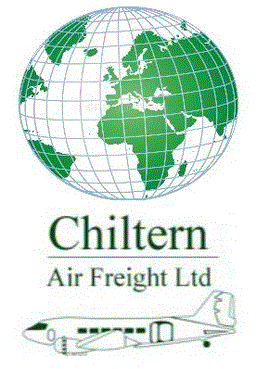
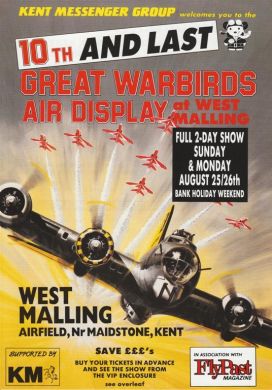 Sally B From film star to Airshow Star
Sally B From film star to Airshow Star 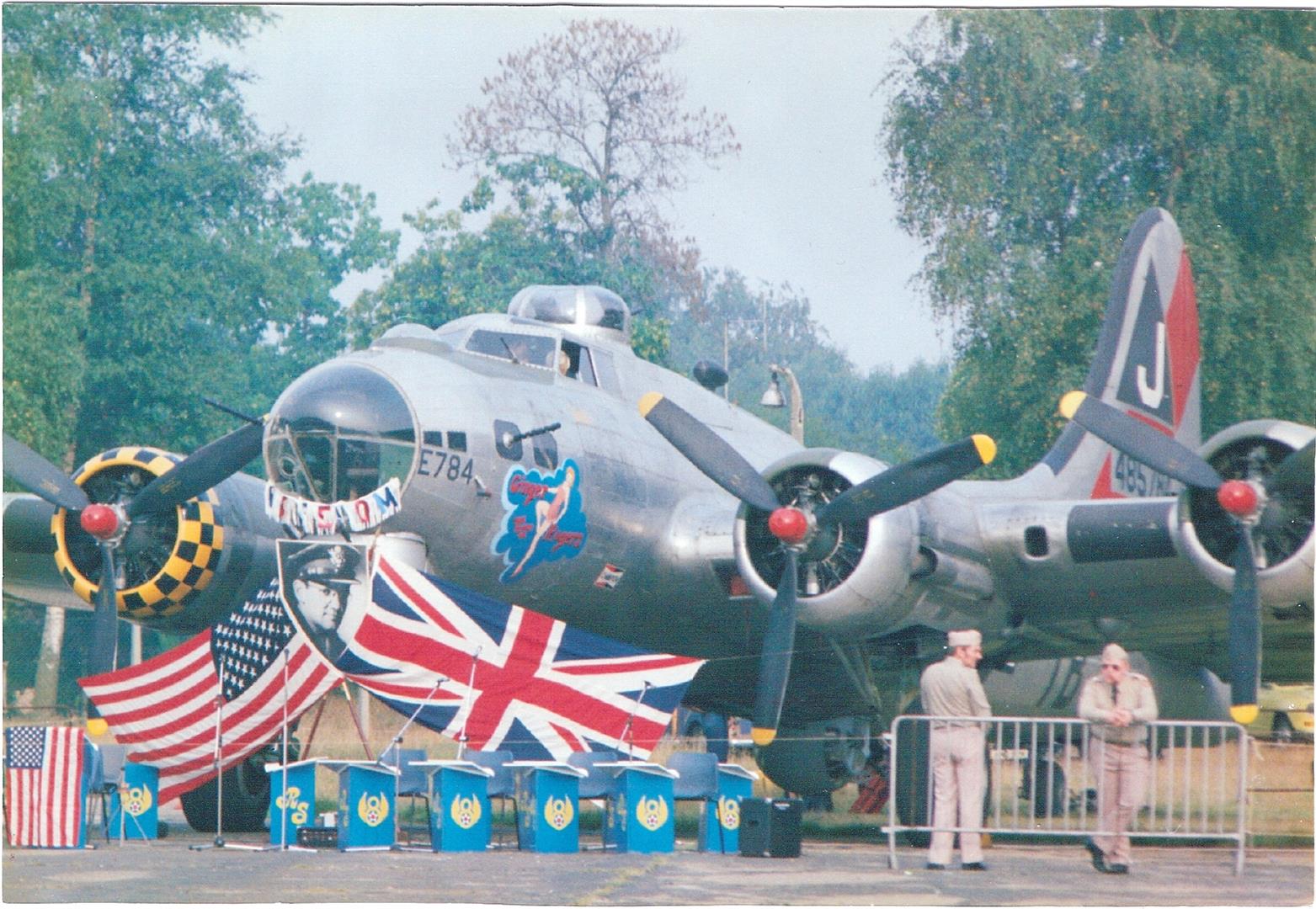 Sally B herself was no stranger to the airfield. In 1981, a film company had taken over the site whilst making the television series “We’ll Meet Again”. (Now released on video and DVD). It told the story of an American bomb group stationed in East Anglia during 1943 and the effect that the airmen had on a local village. Sally B took the starring role as ‘Ginger Rogers’ as well as Sally B. (This was done by writing different names on either side of the fuselage and using different camera angles). The series introduced Sally B to a whole new audience as for the 13 weeks she appeared on national TV and became very well known in virtually every household. Remaining in her natural aluminium skin, the aircraft also acquired a full set of gun turrets, something that she had lacked since her military days. The film starred Susannah York together with Michael Shannon and Gavin O’Herlihy plus a host of ‘extras’. When the news leaked out that the film was being shot at West Malling airfield, many hundreds of local people arrived to see the action. The film company, LWT, staggered by the amount of interest, held an open day on Sunday 10th May 1981 when around a thousand people turned up to see Sally B and some of the cast. They found the airfield very reminiscent of the war with American trucks, bombs, anti-aircraft guns and of course ’Sally B and Ginger Rogers’ together with a number of very realistic cardboard cut-out B-17’s. It was a very nostalgic sight.
Sally B herself was no stranger to the airfield. In 1981, a film company had taken over the site whilst making the television series “We’ll Meet Again”. (Now released on video and DVD). It told the story of an American bomb group stationed in East Anglia during 1943 and the effect that the airmen had on a local village. Sally B took the starring role as ‘Ginger Rogers’ as well as Sally B. (This was done by writing different names on either side of the fuselage and using different camera angles). The series introduced Sally B to a whole new audience as for the 13 weeks she appeared on national TV and became very well known in virtually every household. Remaining in her natural aluminium skin, the aircraft also acquired a full set of gun turrets, something that she had lacked since her military days. The film starred Susannah York together with Michael Shannon and Gavin O’Herlihy plus a host of ‘extras’. When the news leaked out that the film was being shot at West Malling airfield, many hundreds of local people arrived to see the action. The film company, LWT, staggered by the amount of interest, held an open day on Sunday 10th May 1981 when around a thousand people turned up to see Sally B and some of the cast. They found the airfield very reminiscent of the war with American trucks, bombs, anti-aircraft guns and of course ’Sally B and Ginger Rogers’ together with a number of very realistic cardboard cut-out B-17’s. It was a very nostalgic sight.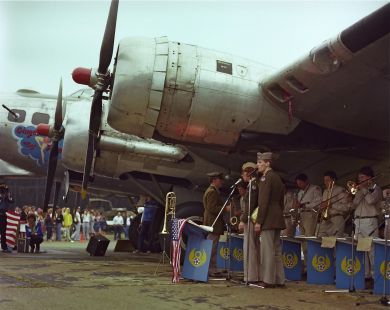 Sunday 19th September 1982 dawned grey with a distinct chill in the air. At West Malling airfield, autumn fog and mist lay heavy on the field. From early morning a steady queue of people had formed at the main gates to the old wartime base, intent on getting the best view of the first Great Warbirds Air Display. By mid-morning the site was alive with military uniforms, historic vehicles and live music. Trade stands were in abundance and beyond the crowd line could be seen a very impressive line-up of warbirds that had arrived the day previously. Nostalgia was about to start in a big way.
Sunday 19th September 1982 dawned grey with a distinct chill in the air. At West Malling airfield, autumn fog and mist lay heavy on the field. From early morning a steady queue of people had formed at the main gates to the old wartime base, intent on getting the best view of the first Great Warbirds Air Display. By mid-morning the site was alive with military uniforms, historic vehicles and live music. Trade stands were in abundance and beyond the crowd line could be seen a very impressive line-up of warbirds that had arrived the day previously. Nostalgia was about to start in a big way.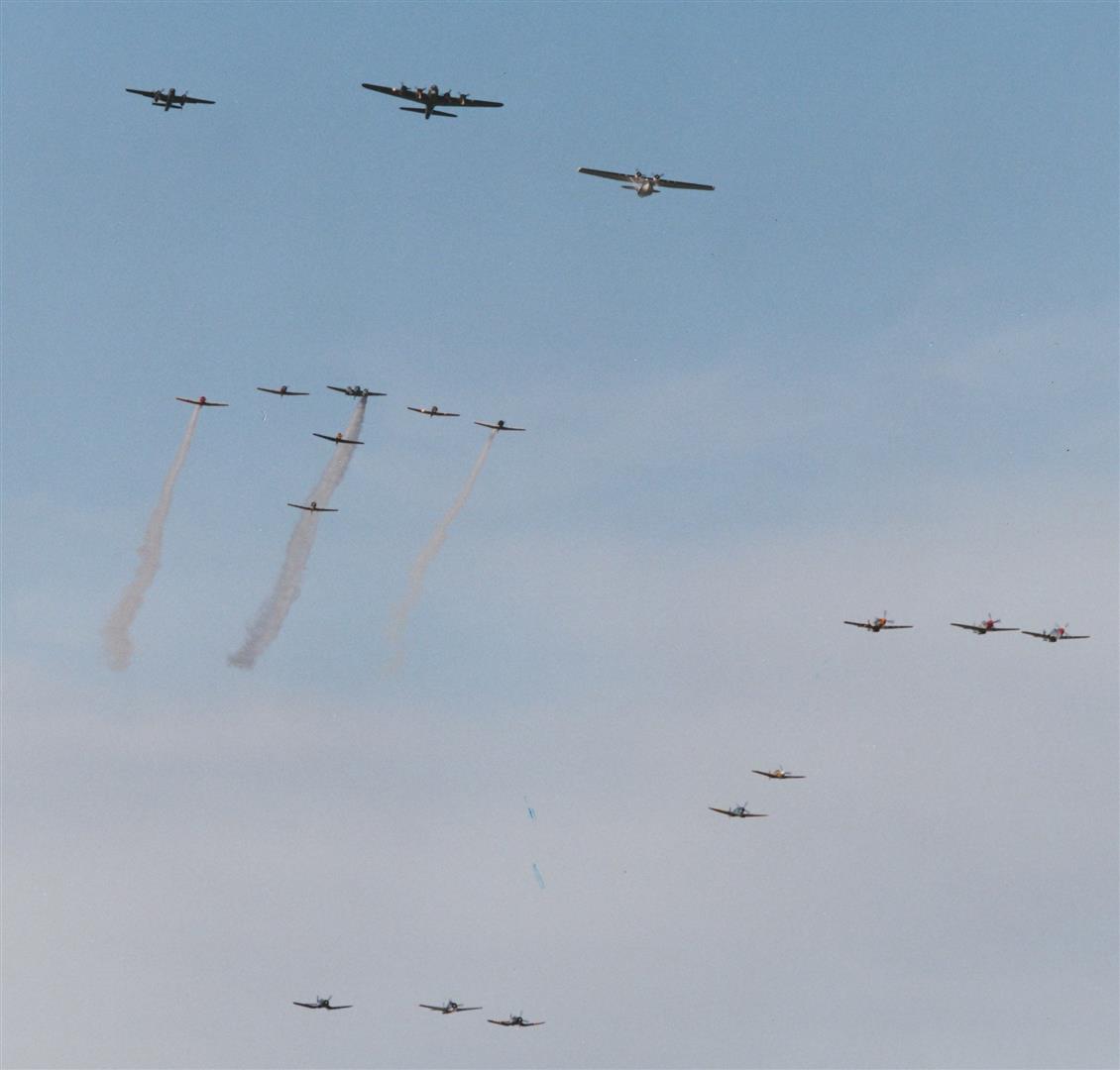 It is true to say that a successful air display requires three ingredients. The right type of aircraft correctly and safely displayed, good organisation prior, during and after the event and of course, good weather. Whilst Elly and John Curthbertson and their team insured the first two, after 1986, West Malling had all three. With the usual warbirds in situ, a capacity crowd watched Concorde return once more to give a stunning display. At 16.30hrs, a new shape could be seen holding on the horizon. As it came into view it developed into the delta wing of the mighty Vulcan, XH558, superbly flown by Flt. Lt. Paul Millikin. Like Concorde, it was a blistering performance. Foreign visitors were also in attendance with the Dutch bringing over their familiar Dakota DH-DDA, a Fokker S.11 Instructor PH-GRB and a Harvard PH-IIB. The Norwegians brought their superb Convair 440 for pleasure flying and caused a stir with their graceful flypast. The start Sally B gave her usual polished performance as once again, “We’ll Meet Again” evoked the usual feelings of nostalgia.
It is true to say that a successful air display requires three ingredients. The right type of aircraft correctly and safely displayed, good organisation prior, during and after the event and of course, good weather. Whilst Elly and John Curthbertson and their team insured the first two, after 1986, West Malling had all three. With the usual warbirds in situ, a capacity crowd watched Concorde return once more to give a stunning display. At 16.30hrs, a new shape could be seen holding on the horizon. As it came into view it developed into the delta wing of the mighty Vulcan, XH558, superbly flown by Flt. Lt. Paul Millikin. Like Concorde, it was a blistering performance. Foreign visitors were also in attendance with the Dutch bringing over their familiar Dakota DH-DDA, a Fokker S.11 Instructor PH-GRB and a Harvard PH-IIB. The Norwegians brought their superb Convair 440 for pleasure flying and caused a stir with their graceful flypast. The start Sally B gave her usual polished performance as once again, “We’ll Meet Again” evoked the usual feelings of nostalgia.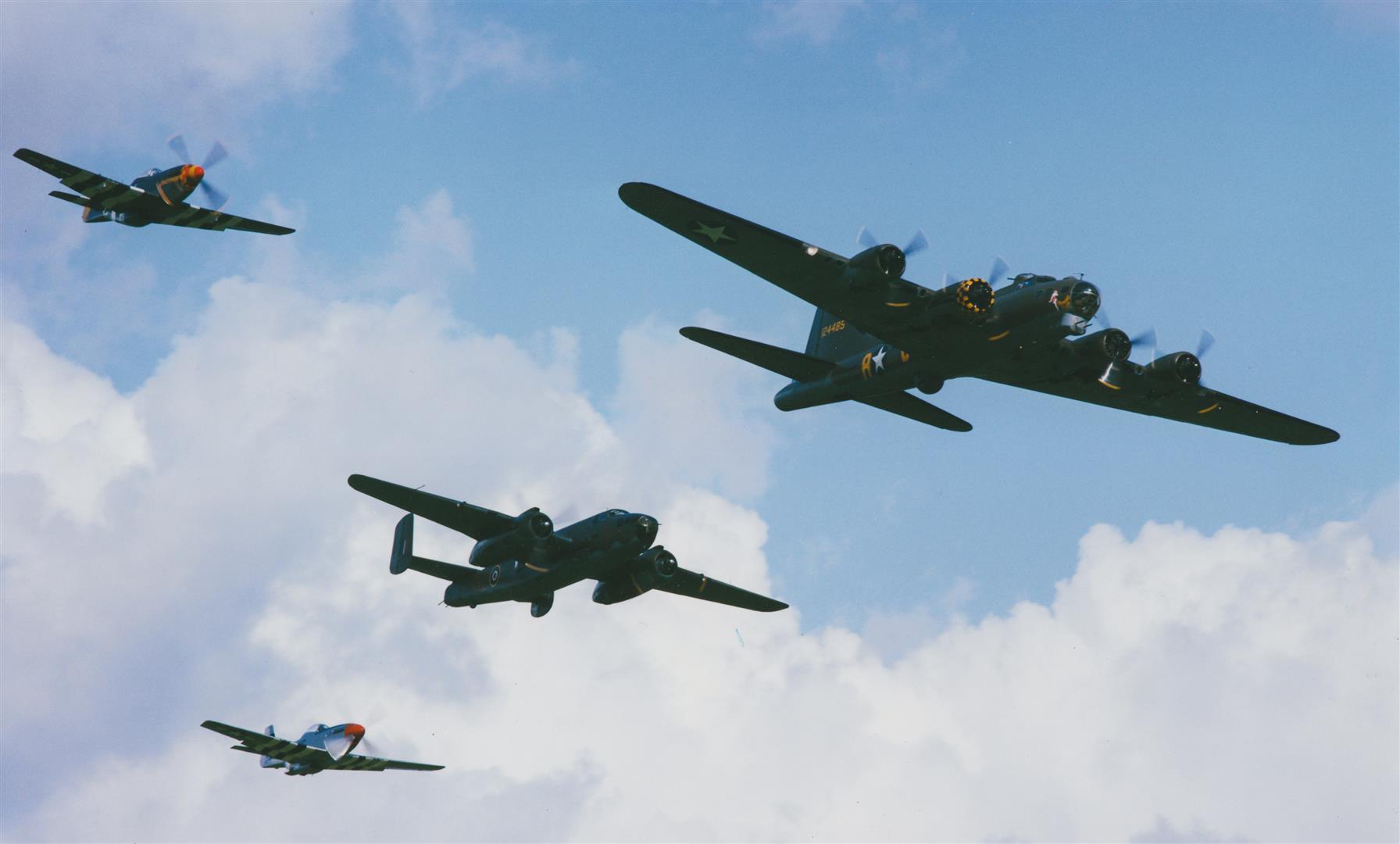 The highlights of the 1990 show consisted of several flying set pieces relating to the making of Memphis Belle. Escorted by her ‘little friends’, Sally B portrayed the Belle admirably. Coming under attack from Ray Hanna’s Me109 and accompanied by the chatter of machine guns relayed over the PA system, the ‘enemy’ was finally beaten off and Sally B/Memphis Belle returned safely to her position in front of the Supporters Club marquee. Another highlight was the surprise appearance of Edward Hulton’s beautiful Sunderland G-BJHS, flown by Ken Emmott and Mike Searle. This majestic aircraft made several flypasts, accompanied by the frantic clicking of cameras. (Sadly, it subsequently left these shores, joining Kermit Weeks’ collection in America.) Once again the mighty Vulcan appeared and gave a stunning display, flown by Sqn Ldr Derek Jones. Time was running out for displaying the aircraft and with no commercial backing forthcoming, it was obvious that the delta shape was soon to go. It was also rumoured that West Malling airfield was earmarked to become an industrial and housing complex.
The highlights of the 1990 show consisted of several flying set pieces relating to the making of Memphis Belle. Escorted by her ‘little friends’, Sally B portrayed the Belle admirably. Coming under attack from Ray Hanna’s Me109 and accompanied by the chatter of machine guns relayed over the PA system, the ‘enemy’ was finally beaten off and Sally B/Memphis Belle returned safely to her position in front of the Supporters Club marquee. Another highlight was the surprise appearance of Edward Hulton’s beautiful Sunderland G-BJHS, flown by Ken Emmott and Mike Searle. This majestic aircraft made several flypasts, accompanied by the frantic clicking of cameras. (Sadly, it subsequently left these shores, joining Kermit Weeks’ collection in America.) Once again the mighty Vulcan appeared and gave a stunning display, flown by Sqn Ldr Derek Jones. Time was running out for displaying the aircraft and with no commercial backing forthcoming, it was obvious that the delta shape was soon to go. It was also rumoured that West Malling airfield was earmarked to become an industrial and housing complex.  1993 was again a two day show at Wroughton, but this time under far better conditions. The display saw the first appearance of the Source Classic Jet Flight with no less than three De Havilland Vampire T55s and a Venom FB4. Magnificent in the extreme was the sight of Sally B flying in formation with the BBMF Lancaster. For the first time in many years, Sally B had a companion B-17 in the shape of the French Fortress Toujours Volante association’s Pink Lady. The two aircraft had not met since the filming of Memphis Belle and one of the more spectacular formations that weekend consisted of the two B-17s flying with two B-25 Mitchells. This display was dedicated to that tower of strength to the B-17, the Sally B Supporters Club. With Hawks, Tornados, Jaguars, Hercules, Harvards and a whole host more, ‘93 was a good year.
1993 was again a two day show at Wroughton, but this time under far better conditions. The display saw the first appearance of the Source Classic Jet Flight with no less than three De Havilland Vampire T55s and a Venom FB4. Magnificent in the extreme was the sight of Sally B flying in formation with the BBMF Lancaster. For the first time in many years, Sally B had a companion B-17 in the shape of the French Fortress Toujours Volante association’s Pink Lady. The two aircraft had not met since the filming of Memphis Belle and one of the more spectacular formations that weekend consisted of the two B-17s flying with two B-25 Mitchells. This display was dedicated to that tower of strength to the B-17, the Sally B Supporters Club. With Hawks, Tornados, Jaguars, Hercules, Harvards and a whole host more, ‘93 was a good year.